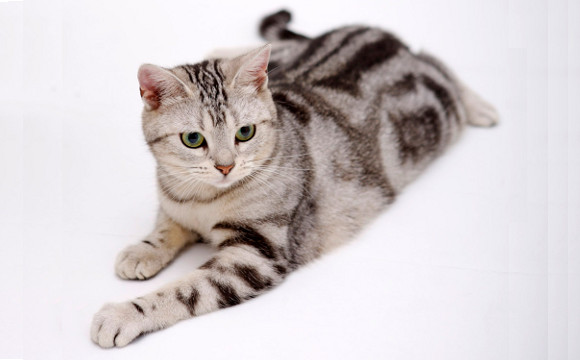History and Origins
The American Shorthair cat, known for its robust health and amiable temperament, has a rich history that dates back over 370 years. These cats arrived in America with European settlers, possibly on the Mayflower in 1620. Initially, they served as working cats, managing rodent populations in barns and fields. Natural selection over centuries honed their hardy constitution and dependable nature.
By the early 1900s, the influx of foreign breeds diluted the original American Shorthair bloodlines. Concerned breeders initiated a selective breeding program to preserve the breed’s natural beauty, mild temperament, and hardiness. This effort faced challenges, including distinguishing purebred American Shorthairs from non-pedigreed domestic cats. Despite the obstacles, the breed gained recognition and respect in the 1960s, with the Cat Fanciers’ Association (CFA) naming a silver tabby male, Shawnee Trademark, as Best Cat in 1965.
Physical Characteristics
The American Shorthair is a medium-sized cat, embodying the “happy medium” in every aspect. They are neither too large nor too small, with a balanced build that supports their active yet not overly energetic lifestyle. Their appearance is characterized by a sturdy body, round face, and wide-set eyes that exude a gentle expression.
The breed’s coat is short and dense, providing protection against harsh weather. The most iconic color pattern is the silver tabby, where striking black markings contrast against a brilliant silver background. This dynamic pattern is both eye-catching and memorable. However, American Shorthairs come in various colors and patterns, each one adding to the breed’s visual appeal.
Personality and Temperament
American Shorthairs are renowned for their adaptable and sociable nature. They possess a quiet demeanor and are known for their gentle voices. These cats are not overly demanding of attention, making them ideal companions for families, singles, and seniors alike. They enjoy being close to their human companions but are not clingy, preferring to maintain a level of independence.
Their history as working cats has instilled a strong sense of self-reliance. American Shorthairs are generally not fond of being picked up frequently but enjoy sitting on laps or next to their owners. They get along well with other pets and children, displaying patience and tolerance.
Health and Longevity
One of the most significant advantages of the American Shorthair breed is its overall health and longevity. These cats are generally free from genetic defects, thanks to their diverse gene pool and natural selection over centuries. They are robust and hardy, often living between 15 to 20 years with proper care.
The breed standard emphasizes that no part of their anatomy should be exaggerated, which helps maintain their physical strength and vitality. Regular veterinary check-ups, a balanced diet, and routine exercise contribute to their long, healthy lives.
Grooming and Care
American Shorthairs have relatively low grooming needs. Their short, dense coat requires minimal maintenance. Regular brushing helps reduce shedding and keeps their coat in good condition. Bathing is seldom necessary, as these cats are good at keeping themselves clean.
Regular dental care, including brushing their teeth and providing dental treats, is essential to prevent periodontal disease. Keeping their claws trimmed and providing scratching posts will help maintain their claws and prevent damage to household items.
Activity and Playfulness
While American Shorthairs are not overly hyperactive, they do enjoy playtime and interactive activities. They appreciate toys that stimulate their hunting instincts, such as feather wands and laser pointers. Puzzle toys and treat-dispensing toys can also keep them mentally stimulated and entertained.
Compatibility with Other Pets and Children
American Shorthairs are known for their friendly and adaptable nature, making them excellent companions for households with other pets and children. They typically get along well with dogs and other cats, provided proper introductions are made. Their tolerant and patient demeanor makes them suitable for homes with young children, as they can handle the noise and activity levels that come with them.
Training and Intelligence
American Shorthairs are intelligent and trainable cats. They respond well to positive reinforcement techniques and can learn basic commands and tricks. Clicker training can be particularly effective with this breed. They also enjoy puzzle toys and interactive games that challenge their problem-solving skills.
Conclusion
The American Shorthair cat is a versatile and well-rounded breed, suitable for various living situations and family dynamics. Their rich history, coupled with their robust health, charming personality, and striking appearance, makes them a beloved choice among cat enthusiasts. Whether you’re looking for a playful companion, a lap cat, or a family-friendly pet, the American Shorthair cat is sure to meet and exceed your expectations.
For more information on the American Shorthair cat breed, visit Cat’s Place.
Additional Resources
- Activity Level: ★★★☆☆☆☆☆
- Playfulness: ★★★★★☆☆
- Need for Attention: ★★★★★
- Affection: ★★★★★☆
- Need to Vocalize: ★★☆☆☆☆☆
- Docility: ★★★★★☆
- Intelligence: ★★★★★☆☆
- Independence: ★★★★★☆☆
- Healthiness and Hardiness: ★★★★★★★☆
- Grooming Needs: ★★☆☆☆☆☆
- Good with Children: ★★★★★★★☆
- Good with Other Pets: ★★★★★★★☆
By understanding and appreciating the unique qualities of the American Shorthair cat, you can provide the best care and companionship for this wonderful breed.

